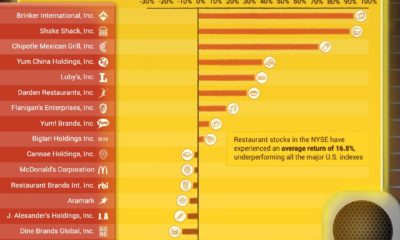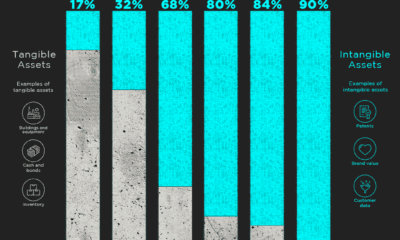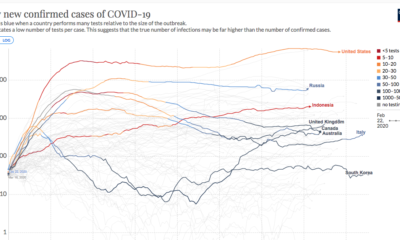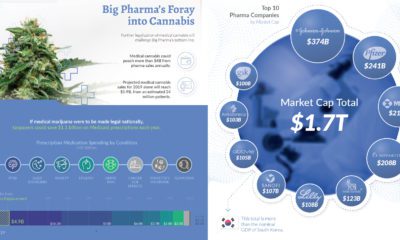In fact, there is so much data out there, that the quantity of it is doubling every two years—and by 2025, there will be 175,000 exabytes of data in existence. This is an unprecedented figure, and it’s hard to put into perspective. To give you some sense, a single exabyte is equal to 1,000,000,000 GB of data, and five exabytes has been said to be roughly equal to “all of the words ever spoken by mankind”.
Common Fallacies With Data
As you can imagine, digging through all of this data can be quite the challenge. Data comes in many different forms and not all of them are easy to analyze. As a result, it is tempting to take shortcuts with data, or to try and fit the incoming data we receive into our pre-conceived notions of how things ought to be. Today’s infographic comes to us from Geckoboard and it shows the common mistakes that people make in analyzing data. We’ve reformatted their PDF to fit here.
15 Common Data Fallacies
How do we avoid painting a bullseye around the arrow, so that we can interpret the meaning of data in a logical, consistent, and methodological way? The key is to understand common mistakes that people make with data, and why these errors skew our interpretations.
Examples of Fallacies
Here are four examples of fallacies, and why each is considered a faux-pas by data scientists.
- Survivorship Bias When people analyze the qualities it takes to be a successful entrepreneur, we typically look at the existing population of established entrepreneurs for clues. However, by limiting our sample just to this “surviving” group of entrepreneurs, we run the risk of survivorship bias. There are lessons we can learn from all of the entrepreneurs who have failed—they are just much harder to find. Integrating that data into the story can help complete a much fuller picture.
- False Causality Did you know that there is a 95% correlation between the marriage rate in Kentucky and the amount of people who drown each year from falling out of fishing boats? (See it, and other bizarre correlations here)
Does this mean that there is some sort of relationship between the two variables? Finding a high level of correlation can happen simply by chance—but awarding false causality is one of the most amateur statistical mistakes in the book. 3. The Gambler’s Fallacy If the roulette wheel turns up black for 26 times in a row, does that mean that it will revert back to red on the next spin? It’s easy to say that the odds don’t change, but imagine being in the moment. The Gambler’s Fallacy happens with data analysis as well: just because something happens unusually frequently over a period of time doesn’t mean that nature will “even it out”. 4. The Cobra Effect Data can be used to measure progress in achieving business goals, but what if there is incentive to game these goals? Wells Fargo, in an effort to upsell existing clients, introduced an incentive called “eight is great”. In short, their employees were encouraged to sell eight accounts per customer, which could take the form of credit cards, savings accounts, and other financial services. In an example of good intentions gone awry, Wells Fargo employees began breaking the rules to meet their targets. Millions of unauthorized credit card and deposit accounts were opened based on this perverse incentive, and the bank was eventually ordered to pay a $142 million settlement. on Even while political regimes across these countries have changed over time, they’ve largely followed a few different types of governance. Today, every country can ultimately be classified into just nine broad forms of government systems. This map by Truman Du uses information from Wikipedia to map the government systems that rule the world today.
Countries By Type of Government
It’s important to note that this map charts government systems according to each country’s legal framework. Many countries have constitutions stating their de jure or legally recognized system of government, but their de facto or realized form of governance may be quite different. Here is a list of the stated government system of UN member states and observers as of January 2023: Let’s take a closer look at some of these systems.
Monarchies
Brought back into the spotlight after the death of Queen Elizabeth II of England in September 2022, this form of government has a single ruler. They carry titles from king and queen to sultan or emperor, and their government systems can be further divided into three modern types: constitutional, semi-constitutional, and absolute. A constitutional monarchy sees the monarch act as head of state within the parameters of a constitution, giving them little to no real power. For example, King Charles III is the head of 15 Commonwealth nations including Canada and Australia. However, each has their own head of government. On the other hand, a semi-constitutional monarchy lets the monarch or ruling royal family retain substantial political powers, as is the case in Jordan and Morocco. However, their monarchs still rule the country according to a democratic constitution and in concert with other institutions. Finally, an absolute monarchy is most like the monarchies of old, where the ruler has full power over governance, with modern examples including Saudi Arabia and Vatican City.
Republics
Unlike monarchies, the people hold the power in a republic government system, directly electing representatives to form government. Again, there are multiple types of modern republic governments: presidential, semi-presidential, and parliamentary. The presidential republic could be considered a direct progression from monarchies. This system has a strong and independent chief executive with extensive powers when it comes to domestic affairs and foreign policy. An example of this is the United States, where the President is both the head of state and the head of government. In a semi-presidential republic, the president is the head of state and has some executive powers that are independent of the legislature. However, the prime minister (or chancellor or equivalent title) is the head of government, responsible to the legislature along with the cabinet. Russia is a classic example of this type of government. The last type of republic system is parliamentary. In this system, the president is a figurehead, while the head of government holds real power and is validated by and accountable to the parliament. This type of system can be seen in Germany, Italy, and India and is akin to constitutional monarchies. It’s also important to point out that some parliamentary republic systems operate slightly differently. For example in South Africa, the president is both the head of state and government, but is elected directly by the legislature. This leaves them (and their ministries) potentially subject to parliamentary confidence.
One-Party State
Many of the systems above involve multiple political parties vying to rule and govern their respective countries. In a one-party state, also called a single-party state or single-party system, only one political party has the right to form government. All other political parties are either outlawed or only allowed limited participation in elections. In this system, a country’s head of state and head of government can be executive or ceremonial but political power is constitutionally linked to a single political movement. China is the most well-known example of this government system, with the General Secretary of the Communist Party of China ruling as the de facto leader since 1989.
Provisional
The final form of government is a provisional government formed as an interim or transitional government. In this system, an emergency governmental body is created to manage political transitions after the collapse of a government, or when a new state is formed. Often these evolve into fully constitutionalized systems, but sometimes they hold power for longer than expected. Some examples of countries that are considered provisional include Libya, Burkina Faso, and Chad.















